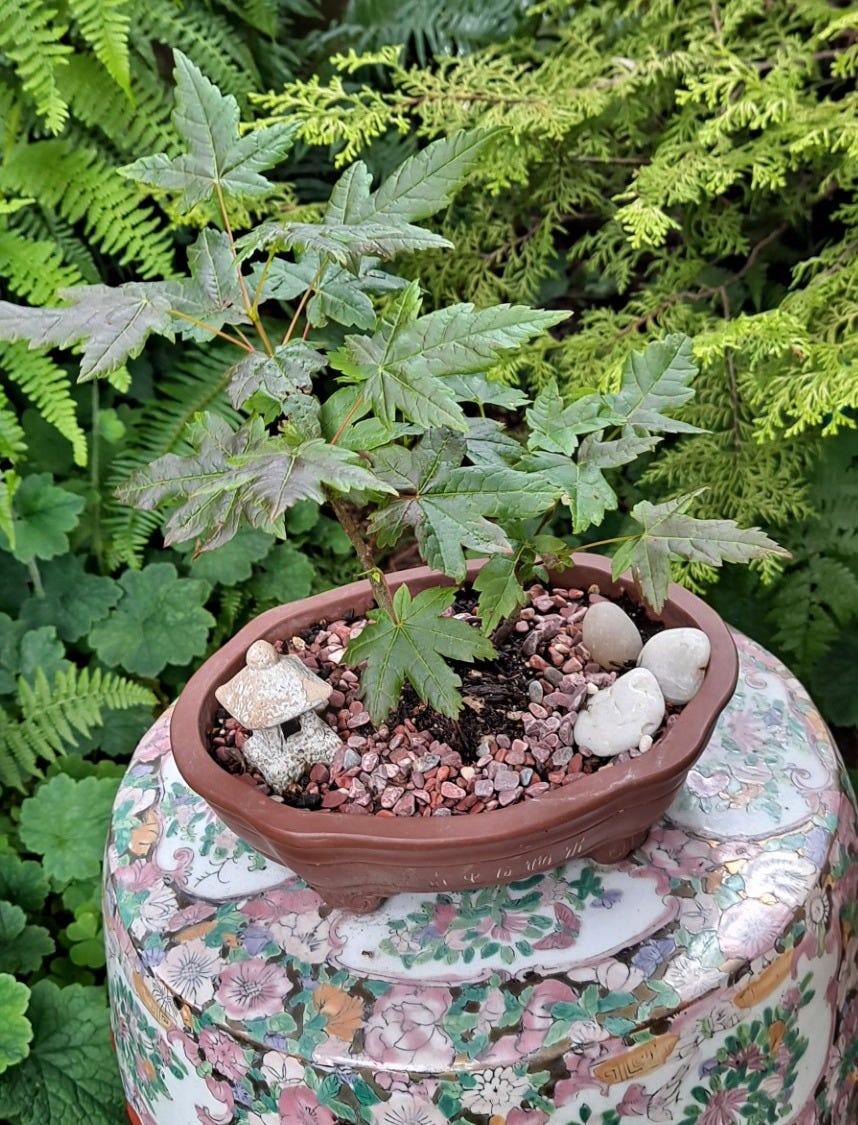Trees in Pots
A neighbor called the other day and asked if I could help him with a project. It involved re-potting a deteriorating Japanese maple. It was a large tree in a large pot, so – due to some recurring back and wrist problems – I had to turn him down. He was very sweet about it and said it was okay if I couldn’t help. He would try to manage by himself.
I admit to more than a few pangs of guilt before I remembered this neighbor is probably young enough to be my son. Realizing this, I was pretty certain he could repot the tree by himself. And that proved to be the case as he called about an hour later to tell me the task had been completed with seemingly no injuries.
He also enlightened me as to the cause of the failure of the tree to thrive. The roots were showing signs of rot.
First of all, any tree in any size pot is considered to be a bonsai. And those of us who have done any reading at all know how important good drainage is to a bonsai. But it goes deeper than that when the bonsai is a Japanese maple. Acer palmatum (botanical name for these loveliest of trees) can withstand quite a bit of water as long as the soil is well drained. They like consistent water, though. And one can hardly argue that the “watering” certainly has been consistent around here these last few months.
But my neighbor had done a few other things that were causing stress to the tree. Things which I’ll bet we all have done at one time or another. The first being he had planted the tree still wrapped in the burlap from the nursery.
I know, the nurseries will tell you that the burlap will rot and the roots will be freed. However, it could take years and years to rot. And some types of burlap are now made from plastic, tied with plastic, or have plastic components. These will never rot and the burlap will stay on, forcing the roots to circle and wrap around each other. So the first step should have been to remove the burlap and even go to the next step which would be to gently “tickle” those roots into long strands that will grow downward and not in a circle around the inside edge of the pot.
Now, since this was a large tree to begin with, the neighbor chose a very nice, large ceramic pot. The pot was heavy to begin with, so he knew by adding the tree and soil to fill the pot would make it impossible to move. So my neighbor filled the bottom half of the pot with Styrofoam peanuts. This is a trick that has been popular with all sorts of gardening magazines in prior years, and I have used it myself. But in this case, the peanuts wound up blocking the drainage hole. This meant all the watering Mother Nature has done was backing up in the bottom of the pot. Bad for the roots, to say the least.
But here’s another problem, and it goes for all bonsai: because bonsai are limited to the soil in their respective pots – no matter how large or small they are – these trees are also limited to the amount of nutrients they can absorb from that potting soil. And if the pot is only half filled with soil, even fewer nutrients available. Or, in other words, bonsai must be fertilized on a regular basis. Exactly when and how much to fertilize will depend on the type and size of tree. For example, I feed my small bonsai with a very weak solution every month. But in this case, I would think a large tree would have had to be fed at least once a week.
The trick is not to feed it so often that it puts on extraordinary growth, both of the roots and of the tree itself.
My neighbor would have been better off to fill the large pot completely with soil, foregoing the packing peanuts, and just resolve not to have to move it. Or perhaps put a set of rollers under the pot.
Bonsai trees that are to be kept in pots for years will also need to have them removed from the pot about every two to three years to root-prune them. This keeps the tree stunted and less likely to outgrow the pot it is in. It also prevents the roots from growing in circles around the inside of the pot.
Which brings another suggestion. Because sometimes the winters here can get cold, ceramic pots may crack in the fluxuating Oregon temperatures. Terra cotta pots are also apt to crack and flake in cold weather, so I move both of these types of pots indoors for the coldest part of the winter. A large potted tree would be less able to be moved indoors. Outside trees don’t like the warmer inside temperatures anyway. So putting this tree into a faux-ceramic pot might have been a better suggestion. They are lightweight and these days are manufactured to look so much like ceramic or terra cotta that sometimes you can’t tell the difference until you lift one. Prices can be more reasonable, too.

